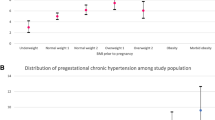Abstract
Purpose
To determine if the best predictor of pregnancy complications is pre-pregnancy body mass index (BMI) alone or in combination with other factors.
Methods
BMI and peripartum outcomes of singleton pregnancies were evaluated. Recursive partitioning and logistic regression modeling was used.
Results
Of the 4,286 cohorts, 26% were obese (BMI >30 kg/m2) and, compared to cohorts with normal weight, at risk for wound infections (P < 0.001), and shoulder dystocia (P < 0.001). High-risk patients (15%; BMI >32.5, parity, pregnancy weight gain of 28 lb by 28 weeks) were at increased risk for wound infection (P < 0.001), endometritis (P < 0.001), shoulder dystocia (P = 0.001) and 5 min Apgar score <4 (P < 0.041) and at lower risk for pre-term delivery (P = 0.007).
Conclusions
Since BMI, parity, and weight gain until 28 weeks together provide better prediction of peripartum complications than BMI alone, these characteristics can be used to triage and refer patients.
Similar content being viewed by others
References
Ehrenberg HM, Dierker L, Milluzzi C, Mercer BM (2002) Prevalence of maternal obesity in an urban center. Am J Obstet Gynecol 187:1189–1193
Isaacs JD, Magann EF, Martin RW, Chauhan SP, Morrison JC (1994) Obstetric challenges of massive obesity complicating pregnancy. J Perinatol 14:10–14
Galtier-Dereure F, Boegner C, Bringer J (2000) Obesity and pregnancy. Am J Clin Nutr 71:1242–1248
Sebire NJ, Jolly M, Harris JP, Wadsworth J, Joffe M, Beard RW, Regan L, Robinson L (2001) Maternal obesity and pregnancy outcome: a study of 287, 213 pregnancies in London. Int J Obes 25:1175–1182
Crane SS, Wojtowycz MA, Dye TD, Aubry RH, Artal R (1997) Association between pre-pregnancy obesity and the risk of cesarean delivery. Obstet Gynecol 89:213–216
Johnson SR, Kolberg BH, Varner MW, Railsback LD (1987) Maternal obesity and pregnancy. Surg Gynecol Obstet 164:431–437
Bianco AT, Smilen SW, Davis Y, Lopez S, Lapinski R, Lockwood CJ (1998) Pregnancy outcome and weight gain recommendations for the morbidly obese. Obstet Gynecol 91:97–102
Kliegman RM, Gross T (1985) Perinatal problems of the obese mother and her infant. Am J Obstet Gynecol 66:299–305
Rasmussen SA, Chu SY, Kim SY, Schmid CH (2008) Maternal obesity and risk of neural tube defects: a metaanalysis. Am J Obstet Gynecol 198:611–619
Chu SY, Kim SY, Lau J, Schmid CH, Dietz PM, Callaghan WM, Curtis KM (2007) Maternal obesity and risk of stillbirth: a metaanalysis. Am J Obstet Gynecol 197:223–228
Salihu HM, Dunlop AL, Hedayatzadeh M, Alio AP, Kirby RS, Alexander GR (2007) Extreme obesity and risk of stillbirth among black and white gravidas. Obstet Gynecol 110:552–557
Cnattingius S, Bergstrom R, Lipworth L, Krammer MS (1998) Prepregnancy weight and the risk of adverse pregnancy outcomes. N Engl J Med 338:147–152
Cedergren MI (2004) Maternal morbid obesity and the risk of adverse pregnancy outcome. Obstet Gynecol 103:219–224
Viswanathan M, Siega-Riz AM, Moos MK, Deieriein A, Mumford S, Knaack J, Thieda P, Lux JL, Lohr KN (2008) Outcomes of maternal weight gain. Evid Rep Technol Assess 168:1–223
Alexander GR, Himes JH, Kaufman RB, Mor J, Kogan M (1996) A United States national reference for fetal growth. Obstet Gynecol 87:163–168
Rasmussen KM, Yaktine AL (eds) (2009) Weight gain during pregnancy: reexamining the guidelines. Institute of Medicine (US) and National Research Council (US) Committee to reexamine IOM pregnancy weight guidelines. National Academies Press (US), Washington DC
Schrauwers C, Decker G (2009) Maternal and perinatal outcome in obese pregnant patients. J Matern Fetal Neonat Med 22:218–226
Rode L, Nilas L, Wojdemann K, Tabor A (2005) Obesity related complications in Danish single cephalic term pregnancies. Obstet Gynecol 105:537–542
Bergholt T, Lim LK, Jorgensen JS, Robson MS (2007) Maternal body mass index in the first trimester and risk of cesarean delivery in nulliparous women in spontaneous labor. Am J Obstet Gynecol 196:163.e1–163.e5
Chu SY, Bachman DJ, Callaghan WM, Whitlock EP, Dietz PM, Berg CJ, O’Keeffe-Rosetti M, Bruce C, Hornbrook MC (2008) Association between obesity during pregnancy and increased use of health care. N Engl J Med 358:1444–1453
DeVadar SR, Neeley HL, Myles TD, Leet TL (2007) Evaluation of gestational weight gain guidelines for women with normal prepregnancy body mass index. Obstet Gynecol 110:745–751
Conflict of interest
We declare that we have no conflict of interest.
Author information
Authors and Affiliations
Corresponding author
Rights and permissions
About this article
Cite this article
Magann, E.F., Doherty, D.A., Chauhan, S.P. et al. Pregnancy, obesity, gestational weight gain, and parity as predictors of peripartum complications. Arch Gynecol Obstet 284, 827–836 (2011). https://doi.org/10.1007/s00404-010-1754-0
Received:
Accepted:
Published:
Issue Date:
DOI: https://doi.org/10.1007/s00404-010-1754-0




